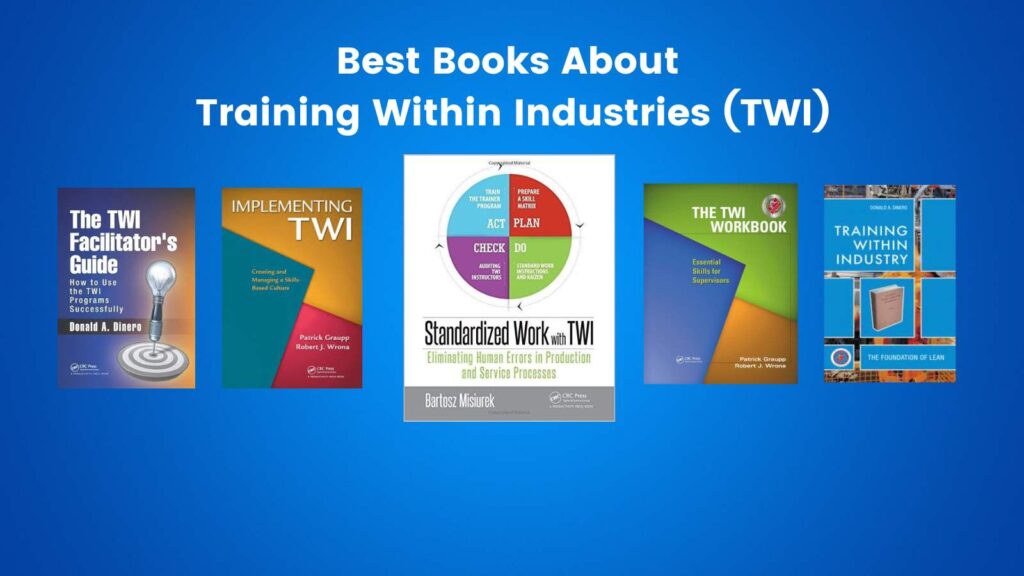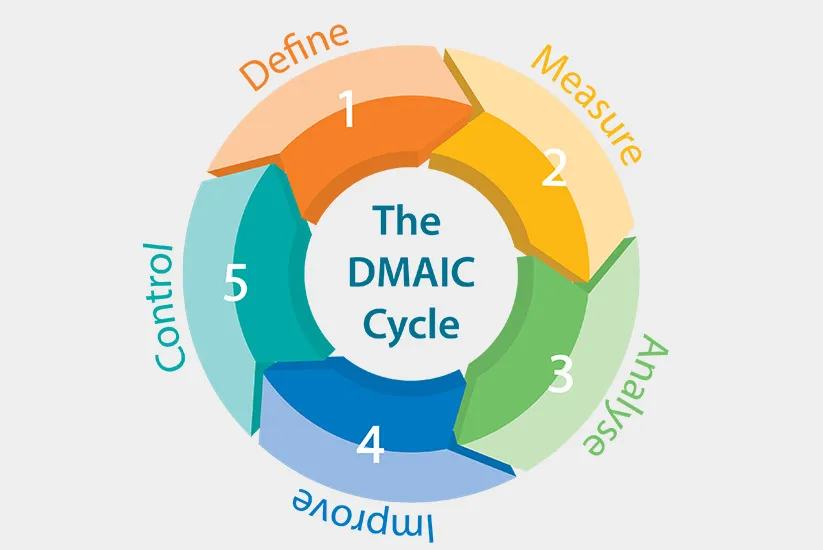Best Books About Training Within Industries (TWI)? See our ranking of the books about the Training Within Industry (TWI) program. TWI is a workforce training program developed during World War II to boost industrial productivity. It was created by the U.S. Department of War (1940–1945) to rapidly train new or reassigned workers in essential job skills at a time when experienced labor was scarce. TWI’s success was dramatic – by war’s end, over 1.6 million workers in 16,000+ plants had been trained, and the program continued overseas in Europe and Japan. In fact, TWI became a foundation for continuous improvement (kaizen) in Japan and heavily influenced the Toyota Production System.
Table of Contents
ToggleWhat is the TWI Program?
The TWI program centers on standardizing work and teaching supervisors how to instruct, improve, and lead. Its core consists of three 10-hour courses – Job Instruction (JI), Job Methods (JM), and Job Relations (JR) – plus a supplemental program for training program development:
- Job Instruction (JI) – teaches supervisors how to break down jobs and train employees to perform tasks correctly, safely, and efficiently (following the motto “If the worker hasn’t learned, the instructor hasn’t taught”).
- Job Methods (JM) – teaches workers to analyze their job steps and improve methods by eliminating wasteful steps and simplifying the work.
- Job Relations (JR) – teaches supervisors to handle people problems effectively and fairly (guided by the idea that “People must be treated as individuals”).
- Program Development (PD) – guides organizations on developing training programs and rolling out JI, JM, JR at scale.
Our ranking of the best books about Training Within Industries is to help organizations in implementing the TWI program.
Best Books About Training Within Industries (TWI)
TWI may be an old program, but its principles are timeless in building a skilled, improvement-minded workforce. Numerous TWI books have been published – from wartime manuals to modern guides – that help practitioners understand and apply these methods. Below, we rank the five best Training Within Industry books (in English) for different needs. If you’re looking for the best book about Training Within Industries – whether a hands-on TWI book for trainers or an in-depth Training Within Industry history – this list has you covered. Each recommendation is accompanied by a brief review and key takeaways. Explore the best booksabout Training Within Industries – TWI.
Standardized Work with TWI: Eliminating Human Errors in Production and Service Processes – dr. Bartosz Misiurek (2016)
Bartosz Misiurek’s book is a practical, up-to-date guide that links TWI with modern lean practices on the shop floor. Unlike some TWI texts that dwell on history, Standardized Work with TWI focuses on implementing standard work through TWI methods to reduce errors and variability. The author presents 41 actionable guidelines for creating effective Standardized Work Instructions (SWIs) and includes tools like a Poka Yoke Generator Sheet for mistake-proofing processes. Misiurek leverages his extensive experience (as a Lean/TWI consultant) to provide ready-to-use examples – for instance, a step-by-step case of tying a Fire Underwriter’s Knot is used to demonstrate how to break down a task and train it using JI methods. The book even shows how the TWI instructional approach can be applied to teach other improvement initiatives such as the 5S system. There is a dedicated section on using TWI’s standardization cycle in areas like Total Productive Maintenance (TPM) and SMED, underscoring TWI’s practical integration with these programs.
Importantly, Misiurek provides a built-in “train-the-trainer” workshop outline for TWI. The final chapters guide readers on how to conduct a TWI-based training course in their own company – essentially a blueprint for developing internal TWI instructors. Thanks to this hands-on approach, readers can not only learn what to do to establish standardized work with TWI, but also how to do it and why it works. Overall, Standardized Work with TWI is an excellent pick for practitioners who want to implement TWI quickly and effectively on the ground. It’s filled with practical tips, real-world examples, and workshop materials that make TWI immediately accessible. If your goal is to develop people and eliminate errors through standard work, this is arguably the best Training Within Industry book to start with.
In our opinion, it is the best book about Training Within Industry. Dr Misiurek is the CEO of Leantrix.
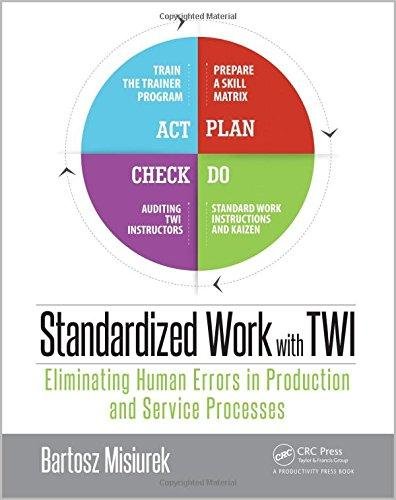
Best Books About Training Within Industries (TWI) – Standardized Work with TWI
Training Within Industry: The Foundation of Lean – Donald A. Dinero (2005)
Donald Dinero’s comprehensive work is often regarded as the definitive reference on TWI’s origin and philosophy. Winner of a Shingo Prize, this book connects the dots between TWI and modern Lean manufacturing. Dinero explains how the WWII-era TWI program – long overlooked in the U.S. – was in fact used by Toyota for decades as a core training and continuous improvement method. The author thoroughly covers TWI’s history and the development of each of the “J-programs,” but he goes beyond history into application. Readers get an in-depth look at all four TWI modules and their purpose: JI (training workers to perform tasks correctly with minimal waste), JM (empowering workers to improve processes), JR (resolving personnel issues analytically), and PD (designing effective training plans). Dinero illustrates how standardized work – built through TWI training – provides the baseline for measurable continuous improvement in any operation.
What sets The Foundation of Lean apart is its level of detail and supporting materials. The book completely explores the principles and methods of each TWI module, including how to deliver JI, JM, JR, and PD training effectively. It shows why TWI is considered a foundational element of Lean thinking, linking TWI concepts to familiar Lean practices (such as kaizen and standardized work) in a clear way. Dinero’s writing is thorough and backed by research. In summary, this classic TWI book is ideal for those who want a deep understanding of how TWI works and why it’s so effective. It provides both the historical context and the technical “how-to” of TWI, making the case that TWI truly is the foundation of Lean. If you’re a Lean practitioner or trainer looking for a rich, authoritative Training Within Industry book, Dinero’s work is a must-read.
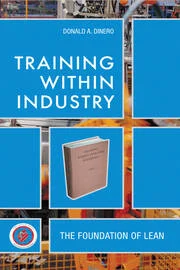
Training Within Industry: The Foundation of Lean – Donald A. Dinero
The TWI Workbook: Essential Skills for Supervisors – Patrick Graupp & Robert J. Wrona (2nd ed. 2016)
Patrick Graupp and Robert Wrona – both leading figures in the TWI Institute – authored this workbook to be an interactive, hands-on training guide for supervisors learning TWI. The first edition of The TWI Workbook won a Shingo Research Prize, and the Second Edition (2016) expands and updates the content for today’s industries. The book is structured as a step-by-step workbook, walking readers through exercises in Job Instruction, Job Methods, and Job Relations, just as a TWI trainer would. It emphasizes that TWI skills are fundamental for establishing Standard Work and continuous improvement, reinforcing how JI/JM/JR create the foundation for Lean operations.
Notably, the second edition adds new material reflecting current best practices and terminology. Graupp and Wrona included new examples to illustrate TWI in modern work settings and placed greater emphasis on safety and prevention of accidents. In fact, this edition introduces an entirely new module on Job Safety (JS) – a fourth TWI module developed in Japan that mirrors the approach of the original three J-programs. The inclusion of JS fills a critical gap by showing supervisors how to apply TWI methods to proactively prevent accidents and injuries on the job. The workbook also discusses TWI’s built-in problem-solving approach and offers more insights into how TWI was reintroduced to the West and implemented at Toyota, information that wasn’t widely known when the first edition was published. Readers will find detailed guidance on key TWI techniques – for example, how to break down a job and identify “important steps” and “key points.” There are even new sections on making balanced training breakdowns and tips for coaching, reflecting feedback from TWI practitioners over the years.
In essence, The TWI Workbook serves as a training manual and reference for anyone tasked with supervisor development. Its workbook format means you can directly practice writing JI breakdowns, JM improvement proposals, and JR problem analyses as you read. For organizations starting out with TWI, this book provides the templates, forms, and step-by-step instructions to begin developing skilled supervisors. It’s an excellent TWI book for “learning by doing,” true to the TWI philosophy of hands-on practice.
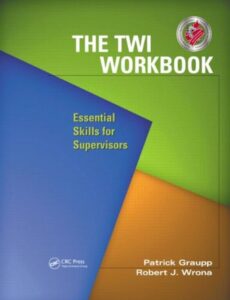
The TWI Workbook: Essential Skills for Supervisors – Patrick Graupp & Robert J. Wrona
Implementing TWI: Creating and Managing a Skills-Based Culture – Patrick Graupp & Robert J. Wrona (2010)
While the TWI Workbook teaches the “how-to” of TWI skills, Implementing TWI by Graupp and Wrona focuses on the broader journey of adopting TWI in an organization. This book is a unique collection of case studies and lessons learned from companies that have rolled out TWI programs in the modern era. More than 60 years after TWI’s creation, businesses both large and small – across manufacturing, construction, healthcare and more – are still using and benefitting from these programs. Graupp and Wrona draw on their decades of experience helping firms worldwide implement TWI, and they share what it really takes to create a skills-based culture built on TWI principles.
Through real-world examples, the authors illustrate the critical elements for successful TWI implementation. One key message is that even though TWI’s methods are straightforward and proven, embedding TWI into an organization’s DNA requires strong commitment, planning, and perseverance. The book discusses common challenges companies face – such as gaining management buy-in, maintaining training quality, and sustaining the momentum – and how to overcome them. Each case study highlights different aspects of using TWI: for example, how one company used TWI Job Instruction to drastically reduce training time for new hires, or how another used TWI Job Relations to improve supervisor-employee communication on the shop floor. By exploring these stories, readers see how to attain the full promise of TWI, not just in theory but in measurable results.
Graupp and Wrona also emphasize the link between TWI and Lean: Implementing TWI shows that mastering TWI skills helps sustain standardized work and continuous improvement in the long run. For those in charge of a Lean transformation or workforce development initiative, this book functions as a strategic guide to deploying TWI. In summary, Implementing TWI is recommended for managers and trainers who already understand the basics of TWI and now want to drive organization-wide adoption. It’s full of practical wisdom on change management, making it easier to introduce TWI training programs and create a culture where continuous learning and improvement thrive.
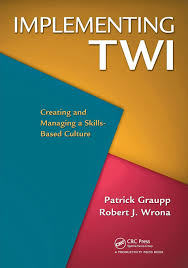
Implementing TWI: Creating and Managing a Skills-Based Culture – Patrick Graupp & Robert J. Wrona (2010)
The TWI Facilitator’s Guide: How to Use the TWI Programs Successfully – Donald A. Dinero (2017)
In this later work by Donald Dinero, the focus is on sustaining TWI programs and keeping their use true to intent. Dinero recognizes that many organizations start using TWI but may stray from its core principles or let the programs lapse over time. The TWI Facilitator’s Guide is therefore written for those who lead or facilitate TWI training to ensure TWI doesn’t fall into “misuse or disuse.” The book first recaps what the TWI programs are – covering JI, JM, JR in a concise way – and then goes into detail about how to properly use and adapt them in a modern context. Crucially, Dinero explains the why behind each element of TWI, so that facilitators understand the underlying principles and won’t accidentally cut corners that weaken the results.
This guide also addresses the reality that companies might need to modify TWI techniques to fit their culture or unique processes. Dinero provides insight into which parts of TWI can be tailored and which should not be changed, by clearly identifying the key principles that make TWI effective. Readers will learn how the TWI “J-programs” tie into larger frameworks like Lean and organizational learning, reinforcing that TWI is not an isolated training, but the foundation of a continuous improvement culture. Additionally, the book is filled with practical advice in a Q&A style – it answers frequently asked questions that new TWI facilitators often have, and offers solutions to problems that arise when running TWI workshops. Topics covered include how to sell TWI to management, how to plan a TWI rollout, and how to sustain the gains long-term. By following this guidance, a facilitator can confidently maintain the quality of TWI training and continuously develop their workforce.
For anyone tasked with supervising a TWI initiative, The TWI Facilitator’s Guide is an invaluable resource. It ensures that TWI’s legacy and power are preserved by teaching exactly how to use the programs correctly and keep improving them without losing their essence. This makes it the perfect capstone to our list – a book that helps you not only start a TWI program, but also keep it thriving for years.
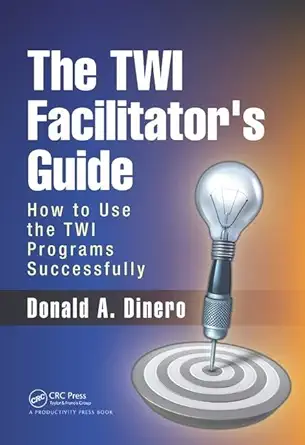
The TWI Facilitator’s Guide: How to Use the TWI Programs Successfully – Donald A. Dinero (2017)
Conclusion – Best Books About Training Within Industries (TWI)
Our ranking of the best books about Training Within Industries is to help to choose the correct book for learning TWI. The Training Within Industry program might have its roots in the 1940s, but these books demonstrate its enduring relevance for today’s organizations. Whether you’re seeking a practical TWI book full of training exercises, a comprehensive Training Within Industry history and reference, or guidance on implementing and sustaining TWI, the titles above have you covered. By learning from the best TWI resources, you can develop supervisors who excel at standardizing work, improving methods, and leading people – the very skills that drive Lean success. In summary, choosing the best book about Training Within Industries depends on your needs: for hands-on standard work training, go with Misiurek’s Standardized Work with TWI; for a deep dive into TWI’s foundation, Dinero’s works are excellent; and for application and culture change, Graupp & Wrona provide invaluable insights. Armed with knowledge from these books, you’ll be well-equipped to leverage TWI’s proven methods to boost workforce capability and continuous improvement in your industry. Share our ranking of the best books about Training Within Industries!
Best Books About Training Within Industries – Links
I am highly experienced marketing professional with over 4 years of experience in the industry. With a strong background in marketing strategies for both B2C and B2B companies. I am skilled in well-versed in the latest digital marketing trends and technologies.

An experienced lean manager with a deep understanding of lean management principles and techniques. I have strong leadership skills, and I am able to motivate and lead teams to achieve results. I am able to communicate effectively, and are skilled at building consensus and working with cross-functional teams. In addition to my experience and expertise, I am also committed to continuous learning and improvement. I am always looking for ways to learn and grow, and I am willing to try new approaches and techniques in order to achieve success.
